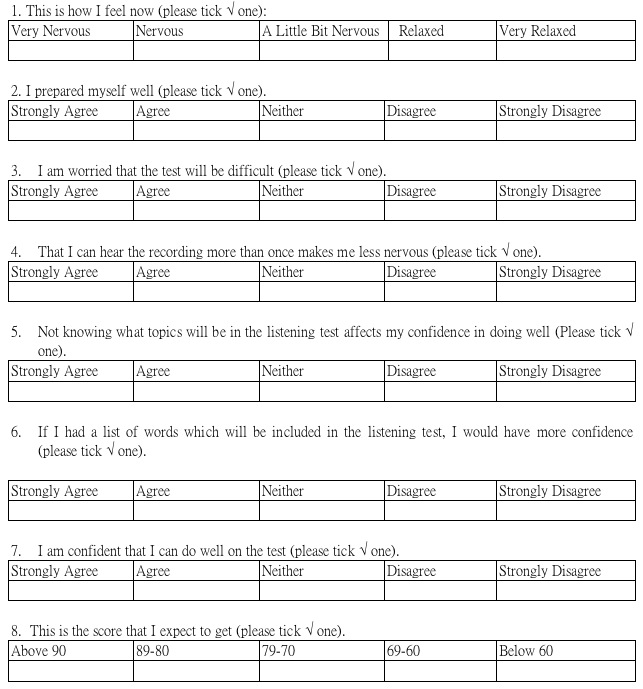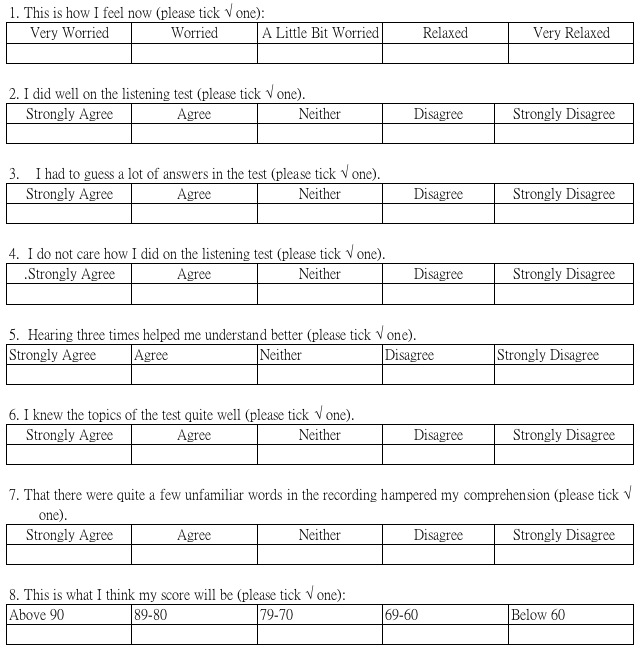
June 2008
Volume 12, Number 1
| Contents | | | TESL-EJ Top |
 |
June 2008
|
||
|
 hotmail.com>
hotmail.com> auckland.ac.nz>
auckland.ac.nz>Foreign language learners typically experience considerable anxiety about taking listening tests. This study investigated how four forms of listening support (pre-teaching of content and vocabulary, question preview, and repeated input) affect the anxiety levels of college students in Taiwan taking a multiple-choice achievement test, which counts for their final grade in a required listening course. Participants included 160 students in four intact classes matched in listening ability. The instruments were a general listening anxiety questionnaire, short measures of task anxiety given just before and after the test, and post-test interviews. Prior the test, the test-takers were uniformly anxious but afterwards, there were significant differences in anxiety according to type of support and level of proficiency. A three-way interaction effect indicated that no single factor accounted for the changes in the learners' listening anxiety. It is concluded that strategy instruction may enhance the effectiveness of support in listening tests.
In a foreign language environment, students frequently learn English through formal instruction in the classroom, with their first language as the medium, and may have little exposure to the language outside the study context. Their ability to comprehend spoken English is can be limited, and is further diminished in situations where affective factors like anxiety influence their performance (Chen & Chang, 2004). Such a situation occurs when students take a listening test that counts towards a final grade in an English course. As Bachman and Palmer (1996) note:
[A]ffective schemata, in combination with characteristics of the particular [test] task, determine, to a large extent, the language user's affective response to the task, and can either facilitate or limit the flexibility with which he responds in a given context. (p. 65)
This raises the question as to whether it is possible to design and administer a listening comprehension test in a way that enhances the learners' opportunity to demonstrate their ability by reducing the effects of anxiety to the extent possible.
As numerous authors have pointed out (see, for example: Brown, 1990; Cheng, 2004; Chang, 2005a; Dunkel, 1991; Rost, 1990; 2001; 2006), there are many variables that can influence performance on a listening task: the input text, the speaker, the test-taker and the response task. Some specific aspects of the listening task, such as speech rate (Blau, 1990; Derwing & Munro, 2001; Griffiths, 1990, 1991; Jensen & Vinther, 2003; Tauroza & Allison, 1990) and others discussed below, have received attention from researchers. However, as Read (2002) notes, there has been relatively little investigation of the effects of many of the design features in listening tests.
From the perspective of foreign language learners, as analyzed by Buck (2001), there are numerous difficulties to be confronted in listening tasks, such as unknown vocabulary, unfamiliar topics, fast speech rates, and unfamiliar accents. And if, in the interests of authenticity, learners hear the input material only once, they have limited opportunity to make adjustments once the input begins. In a situation where there exists less control than in a written test, it is not surprising that affective variables play a large role in the learners' performance. In this study, we set out to explore whether it is possible, through the use of certain interventions, to reduce the negative effects of listening anxiety and provide the basis for a more valid assessment of the learners' listening comprehension ability.
In research on the affective dimension of second language learning, the importance of language anxiety has emerged. Horwitz, Horwitz, and Cope (1986) propose that foreign language anxiety is a distinct variable composed of three components, the most relevant of which (for the present study) is test anxiety. Their conception received empirical support from the work of MacIntyre and Gardner (1989), who demonstrate through factor analysis that foreign language anxiety is separable from general anxiety, and that it is negatively correlated with achievement in the foreign language. In a later study (Gardner & MacIntyre, 1993), the researchers find negative correlations with a whole range of achievement measures, and even more so with self-assessments of proficiency, leading them to conclude that "[t]he best single correlate of achievement is Language Anxiety" (p. 183).
The negative relationship between anxiety and achievement or performance has been confirmed in several subsequent studies involving all four language skills: speaking (Liu, 2006; Steinberg & Horwitz, 1986; Young, 1986), writing (Masny & Foxall, 1992), reading (Saito, Garza, & Horwitz, 1999) and listening (Elkhafaifi, 2005; Mills, Pajares & Herron, 2006). Understandably, the effect of anxiety is more marked in a high-stakes assessment situation. Young (1986) found that anxiety played less of a role in an informal, practice version of the Oral Proficiency Interview. More recently, Mills et al. (2006) reported that their students, especially the male students, put less effort into completing a low-stakes proficiency test than in a formal final test. Similarly, In'nami (2006) found test anxiety did not affect the performance of his Japanese students on a low-stakes listening test.
With regard to listening anxiety specifically, Aneiro (1989) found that the "apprehension" of her Puerto Rican college students was most affected by their level of listening proficiency, followed by the amount of exposure to the foreign language and their general language competence. Elkhafaifi (2005) and Mills et al. (2006) have also obtained evidence that learners' anxiety varies according to their level of ability in foreign language listening.
Other variables were identified by Vogely (1998), who looked at sources of listening anxiety among learners of Spanish at an American university, as reported by the students themselves. Half of their responses focused on the characteristics of the input (nature of the speech, level of difficulty, lack of clarity, lack of visual support, and lack of repetition) as being a major source of anxiety. In particular, they were concerned about speech that was spontaneous, too fast for them, poorly enunciated, or in an unfamiliar accent. The students also associated the level of difficulty with unknown vocabulary, complicated syntax, and unfamiliar topics. When asked to suggest how their listening anxiety could be reduced, about a third of the students' responses focused on input-related factors, such as making the input more informal and ungraded, selecting familiar and meaningful topics, and using known vocabulary.
Some authors have proposed other ways of reducing listening test anxiety, for example, by teaching listening strategies and letting students have more practice (Elkhafaifi, 2005). However, little empirical research has been done to test whether these suggestions are effective or not. One study by Arnold (2000) explored a method of reducing anxiety about a listening examination involving two stages: relaxation and visualization. The study showed that university students in Spain who experienced visualization practice made significantly fewer errors in a listening post-test than those who did not. Arnold argues that "[t]raining of this nature might help free energy previously used in worrying for the much more productive cognitive operations of language processing" (p. 784).
Although relaxation practice may have some effect, it would not normally be considered appropriate as part of the administration of a formal test. As Bachman and Palmer (1996) point out, "[o]f the many factors that can affect test performance… the characteristics of the test task are the only factors directly under our control as test developers" (p. 47). They argue that the most suitable way to address concerns such as the negative effects of test anxiety is through a careful consideration of test design issues. Thus, we need to review various means by which a listening test can be designed to reduce the negative affect that many learners experience.
Although research on reducing listening anxiety as such is limited, there is a broader literature on providing various forms of support for learners as they undertake listening comprehension tasks, so that they can be "tuned in" (Underwood, 1989, p. 30) before the task begins, and so they have more opportunity both to crack the linguistic code and to process the content of the input. Such support may result in reduced anxiety in assessment contexts. In the language testing literature, there are studies on the effects of allowing the test-takers to preview the test questions and to hear the input material more than once; these can be seen as forms of support which are incorporated into the test design. Less work has been done on pre-listening activities to familiarize learners with the aspects of the input such as the topic or key lexical items. Let us now look in turn at the various forms of support that were included in the present study.
Although authors argue that pre-listening activities have positive effects, there is little research regarding the effectiveness of classroom activities designed to improve performance on a specific listening comprehension task. Several studies (Markham & Latham, 1987; Long, 1990; Schmidt-Rinehart, 1994) have shown that learners more easily understand oral texts that are familiar, particularly those that are related to their own national, cultural, or religious backgrounds. In Taiwan, Chiang and Dunkel (1992) and Teng (1996) found that Chinese learners performed better on input material about Confucianism and the Dragon Boat Festival than on passages about such American topics as the Amish and Thanksgiving Day. Chang and Read (2006) also found that providing more advanced students with background knowledge enhanced learners' comprehension, but its effect was less marked for lower level students.
There is some evidence on the effects of pre-reading activities that may be applicable to EFL listening as well. In a review of the research on pre-teaching vocabulary to L1 readers, Graves (1986) found that the learners needed multiple encounters with the words in different contexts and opportunities to process them actively if the vocabulary instruction were to have any effect on reading comprehension. In addition, a study by Stahl et al. (1989) showed that vocabulary and background knowledge were independent sources of difficulty in understanding a written text. Adequate pre-teaching of vocabulary could assist students to comprehend the text at a propositional level, whereas the acquiring of background knowledge contributed to a more global understanding of the text.
More recently, Hsieh (1999) investigated the effects of prior vocabulary instruction and cultural background knowledge activation on Chinese college students' EFL reading comprehension. She found that giving vocabulary instruction alone increased only the students' vocabulary test scores, whereas providing background knowledge improved both the vocabulary and reading comprehension scores. However, the students performed the best when they were given both vocabulary instruction and background knowledge of the culture.
Therefore, the indications are that providing background knowledge of a written text is more effective than teaching vocabulary in enhancing learners' reading comprehension, and some investigation is needed to see whether these findings can be generalized to EFL listening comprehension.
Another way to orient learners to a listening comprehension task is by allowing them to preview the questions just before they undertake the task. There has been debate in the literature about the effectiveness of this approach. Some authors (Buck, 1991; Cohen, 1984; Shohamy & Inbar, 1991) have suggested that question preview may help to focus the listeners' attention in the right direction, whereas others (Ur, 1984; Weir, 1993) believe it may alter the nature of listening processing by distracting the test-takers from concentrating on the oral input.
In their research, both Groot (1975) and Sherman (1997) found that the test scores were essentially the same whether questions were given before or after the learners had listened to the stimulus material. However, Sherman's experiment also showed that significantly higher scores were achieved with a "sandwich" format, whereby the test-takers listened to the input text once, were given the questions, and then heard the text a second time. It was also the format that created the least anxiety and was strongly preferred by the test-takers over both the "questions-before" and "questions-after" conditions.
In Buck's (1991) study, which involved introspective case studies, test-takers who previewed the test questions reported that it helped them understand better and they listened specifically for answers to the questions. More recently Chang (2005a) found that the effectiveness of question preview was influenced by the type of questions (short-answer versus multiple choice) and the test-takers' language competence. High-level EFL students considered it more helpful to preview multiple-choice questions than short-answer ones; however, low-level students perceived no real difference between the two. This study suggests that if reading skill is required to comprehend test questions, low-level students will be at a disadvantage.
Repetition has always been used as a strategy in second language learning and teaching to make information more comprehensible, but relatively little research has been conducted on its effect in listening assessment. Here, we are primarily concerned with the complete repetition of the input material, rather than the kind of lexical and syntactic reinstatements within a lecture text that have been investigated (see, for example, Chaudron, 1983; Chiang & Dunkel, 1992). Nevertheless, one study combined the two strategies. Cervantes and Gainer (1992), who worked with English majors at a Japanese university, compared the effects of listening once to simplified input versus listening to difficult text with or without repetition. They found that there was no significant difference between the scores for groups hearing the syntactically simplified version and the complex version with repetition. However, the scores for the groups hearing the complex version with repetition were higher than the scores for those hearing the complex version without repetition. This result indicates that repetition facilitates comprehension.
Another study showing the positive influence of repeated input was undertaken by Berne (1995). In this case, the effect of repetition on learners' comprehension of videotaped input was compared to question preview and vocabulary preview. When the participants watched the videotape a second time, the mean scores for all three groups were significantly higher than after the first viewing. Question preview also had a significant effect on comprehension after one viewing, but on the other hand, studying relevant vocabulary before listening did not enhance the learners' comprehension of the material on the video. Elkhafaifi (2005) replicated Berne's study with learners of Arabic and the results were comparable.
Some studies in Taiwan have focused on learners' perceptions of the role of repetition, both in listening practice and in a testing situation. Chang, Chang and Kou (1993) found that Taiwanese college-level students were most bothered by fast speech. Repeated listening was the most popular strategy that they used to improve comprehension, regardless of level of proficiency. According to another survey of college students by Teng (1998), 47 percent preferred to hear the input for a listening test twice, whereas the other 53 percent wanted to listen three times or more. Given this high percentage of students requesting repeated input, its effects deserve further investigation as a means of reducing listening test anxiety.
Therefore, regarding the various forms of listening support that we set out to investigate, some research findings show clearly that repetition of input enhances listening comprehension. For the value of previewing test questions, the evidence is more mixed, and there is little to report by way of empirical studies on the contribution of preparatory activities to learners' performance on a listening task. Although there are some indications that learners themselves prefer to preview test questions and to hear input more than once, we have not been able to find any previous research on how such forms of support might affect listening anxiety, particularly in a high-stakes assessment situation.
In this study, we set out to investigate the effectiveness of four forms of listening support, which we label topic preparation (TP), vocabulary instruction (VI), repetition of the input (RI), and preview of questions (PQ). We sought to answer the following questions:
Many college students in Taiwan are required to take an English listening course as part of their undergraduate studies. The length of the course and how it is taught are determined by whether the students are English majors or not. For business majors, such as the participants in this study, the required listening course lasts for two semesters and meets two hours per week, for a total of 72 hours all told. For these and other non-English majors, the course mainly focuses on comprehending aural input, particularly of the conversational type, whereas English majors are exposed to broader content, which focuses not only on general comprehension of English but also on acquisition of proficiency in a more general sense. The textbooks chosen for non-English majors usually have theme-based content developed by materials writers, such as how to book a flight or how to order a meal in a restaurant. In general, non-English majors rely on the teacher's formal instruction in the classroom and few students practice listening outside the class. Consequently, the progress is slow and, without external support, comprehension can be rather limited.
The participants in the study were 160 business majors who were taking a required course in English listening at a college in Taiwan. They had learned English as a foreign language in school for about seven years on average and had little opportunity to use the language outside of class. The students were in four intact classes of 40 students each[1], which were expected to be of similar ability in English as a result of the pseudo-random procedure by which they had been allocated to their classes. This was confirmed by the administration of a pre-test, which was a form of the listening section of the Test of English for International Communication (TOEIC), consisting of 100 multiple-choice items. A one-way ANOVA showed that the differences in the class means were not significant (see Table 1). The mean of correct responses was 39.73, with a standard deviation of 6.01. Converted to standard TOEIC listening scores, this represents a range from 50 to 265, with a mean of 160, and indicates that the students were at a beginning to intermediate level in listening proficiency in English.
Table 1. Descriptive statistics for listening proficiency (TOEIC scores) in each group
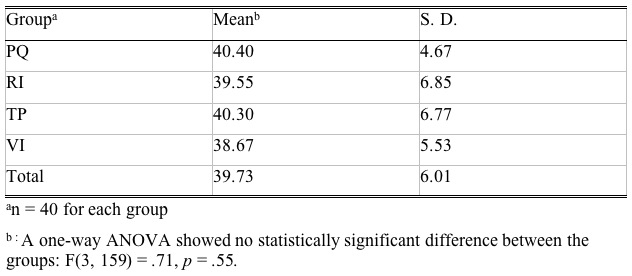
In order to use level of listening proficiency (LP) as a variable in the analysis, the whole group of 160 participants was divided at the median TOEIC score of 39 into higher LP (n=78; M =44.64) and lower LP (n=82; M =35.06) subgroups. This classification is obviously a relative one, which does not represent the students' proficiency in an absolute sense.
To measure the participants' anxiety about listening, a questionnaire was developed consisting of 33 Likert-type items with the standard five-point response scale from "strongly agree" to "strongly disagree". The first part, which had 22 items, focused on anxiety associated with the experience of listening to English in the classroom setting and yielded a measure of General Listening Anxiety (GLA). These items were adapted from the Foreign Language Classroom Scales of Horwitz et al. (1986), and from Young's (1990) Speaking Anxiety Questionnaire. The other 11 items concerned the participants' experience of, and feelings about, taking listening tests; this part measured General Listening Test Anxiety (GLTA). The items were developed on the basis of student responses reported in the studies by Vogely (1998) and Chang (2005b).
It was also necessary to measure the participants' reactions to the four forms of listening support included in this study. Thus, eight versions of a task-specific questionnaire were developed, consisting of separate pre-test and post-test versions to be administered to each of the four groups just before and just after they took the listening test. An English translation of the two versions for the Repeated Input group can be found in Appendices 1 and 2. The questionnaire was composed of eight items, each with an appropriate five-point response scale, to elicit the test-takers' feelings about the listening test and their perceptions of the value of the listening support they had received in their group.
A listening test was developed that would be suitable for the level of the learners in terms of its vocabulary level, sentence length, and syntax. The input material consisted of two scripted talks recorded on audiotape by a native-speaking ESL teacher. One, on the topic of good health (260 words long), was taken from a textbook for EFL learners (Foley, 1994), whereas the second talk (369 words in length), describing some social customs in New Zealand, was written by the researchers. Neither of the topics was covered in class before the experiment took place. For each talk, there were 15 multiple-choice items (in English), making a total of 30 items for the test. Some items focused on main ideas, but most were based on specific details in the talks.
Background information for the Topic Preparation group. For students in the topic preparation (TP) group, the first author produced texts written in Chinese on each of the test topics. One passage focused on good health, and was about 300 words long and provided information on how to avoid heart attacks by proper diet and exercise. The second reading passage (about 500 words) made a comparison between Taiwan and New Zealand in terms of geography, population, and society. In both cases, the passages presented general information about the test topic, rather than particular facts that were the basis of answers to the items in the test.
Word lists for the vocabulary instruction group. Words that were relevant to each topic were selected from the listening texts and listed together with their Chinese equivalents. The list for good health contained 23 words, and there were 25 words from the text on New Zealand's social customs. In a pilot study, the students reported that they were already familiar with about two-thirds of the listed words.
The four intact classes were taught throughout the semester by the first author and they participated in the study during their scheduled two-hour class time. Three weeks before the main data-gathering, the students completed the general questionnaire on anxiety about listening activities and a listening proficiency test. One week in advance, they were told there would be a listening test in class the following week, which would count as 60% of their final grade for the course. The rationale for making the test part of the course assessment was to raise the stakes for the students, thereby creating a situation in which test anxiety would play a role and where the possible differential effects of the various forms of listening support in reducing anxiety could be observed.
In the experiment itself, each of the classes took the listening test in conjunction with one particular form of listening support, except that all four groups were allowed to preview the questions, so this was in fact the control condition. The test was administered in the second hour of the two-hour class period. Two of the conditions, question preview (PQ) and repeated input (RI), did not involve any preparatory activity, and so in the first hour these two groups listened to instructional material, unrelated to the test content, from the CD-ROM which accompanied their course textbook.
In the first hour of their class, the topic preparation (TP) group read the materials written in Chinese related to the two topics of the texts in the test. After they had finished reading, the teacher led a discussion in Chinese about the reading material. Meanwhile, in their first hour, the vocabulary instruction (VI) group was given the vocabulary lists to study. The teacher also modeled the pronunciation of each word and played a number of pre-recorded dialogues to give practice with listening to some of the target vocabulary in connected speech.
In the second hour, all four groups took the listening test in their normal meeting room, an audio-visual language classroom where every student had a separate seat, a monitor, and a set of headphones. The test tapes were played through the language laboratory console, and the students could listen either through the room speakers or their headphones, according to their personal preference. The question preview, topic preparation, and vocabulary instruction groups previewed the test questions and then listened to the input texts once. The repeated input group followed Sherman's (1997) sandwich model: they listened to the texts once and then previewed the questions, followed by two more hearings.
Before the test began, all students filled out the specific pre-test questionnaire, to record their feelings at that point. Similarly, they completed the post-test questionnaire immediately after the end of the test. In addition, six students from each group then participated in an interview with the teacher to provide elaborated feedback on their experience of taking the test. The interview findings will not be reported in detail here, but will be drawn on selectively in the discussion section to help interpret the results of the statistical analyses.
SPSS[2] 12.5 for Windows was employed for the statistical analyses. First, descriptive statistics were calculated for the various measures used in the research. Since the study investigated whether the participants' anxiety was affected by different forms of listening support (LS) and their listening proficiency (LP) on different occasions (before and after the test), the experimental design to address the research questions consisted of one dependent variable, task anxiety, and three independent variables, which were LS (4 groups: PQ, RI, TP, and VI), LP (2 levels: high and low), and Occasions (2 times: before and after). In the following presentation of the results, "Occasion 1" refers to before the task, and "Occasion 2" after the task. The participants' task anxiety was measured two times, so the data were analyzed by means of ANOVAR (analysis of variance with repeated measures), a 4 x 2 x 2 design. The between-subject factors were LS and LP, and the within-subject factor was Occasions.
The listening anxiety questionnaire had an overall reliability of .83. The mean ratings of all the participants for general listening anxiety (GLA) and general listening test anxiety (GLTA) are displayed in Table 2. The overall means of 3.56 for GLA and 3.86 for GLTA on a 5-point scale indicated that the participants considered English listening moderately anxiety-provoking in both general and testing situations, but more so when they were taking a test.
Table 2. Descriptive statistics for anxiety about listening and listening tests
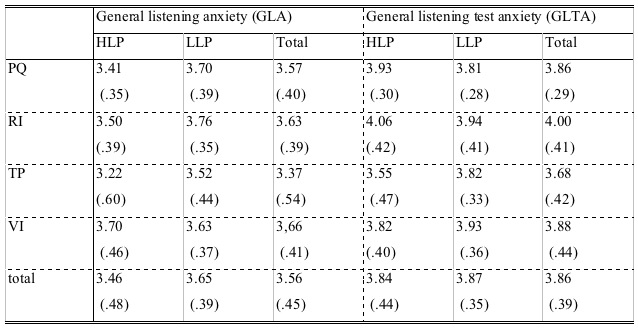
An inspection of the group means shows that the TP group tended to have lower listening anxiety than the other three groups. When the different levels of listening proficiency were taken into account, the higher proficiency (HLP) students in the TP group reported the lowest anxiety on both measures (GLA and GLTA), and there was no noticeable difference among the other subgroups on GLA. In terms of anxiety about tests (GLTA), the higher proficiency students in the RI group rated themselves the highest.
The mean score on the listening comprehension test for the entire sample was 17.11. Overall, the TP group achieved the highest mean score (19.12), followed by the RI (17.95) and PQ (16.47) groups, and the VI group scored the lowest, with a mean of only 14.90. The reliability coefficient (Cronbach's α) was 0.70, a satisfactory figure for a teacher-constructed test of 30 multiple-choice items.
In the General Linear Model (GLM) analysis (Table 3), significant main effects were found for listening support (LS) (p <. 001) and listening proficiency (LP) (p <. 01). However, the interaction of LS and LP was also found to be significant (p <. 05), which meant that the effect of the forms of LS differed according to the proficiency level of the learners. It should be noted, though, that the effect sizes for LP, and LS* LP were quite small, only 0.04 in each case, and the observed power was only .82 and .66 respectively.
Table 3. Results of the univariate GLM analysis of the effects of listening support (LS) and listening proficiency (LP) on listening comprehension

Due to the significant interaction effect, we needed to look at the main effect of LP given all levels of LS, and LS given the two levels of LP. As shown in Table 4, the higher proficiency subgroup in the RI group performed the best, followed by both the higher and lower proficiency subgroups in the TP group. On the whole, HLP students in the PQ and RI groups scored much higher than LLP students, whereas the two subgroups performed equally well in the TP group and equally poorly in the VI group.
Table 4. Descriptive statistics for the listening comprehension test scores

The mean ratings and standard deviations for specific anxiety are shown in Table 5, with separate figures by group, by level of listening proficiency (HLP and LLP) and by occasion (before and after the test). Before the test, the RI and TP groups reported lower anxiety than the PQ and VI groups, but the difference was not great. After the test, the RI and TP students reported even lower anxiety, whereas the anxiety level of the VI and PQ groups rose. In terms of listening proficiency, the higher proficiency students in the TP group had the lowest anxiety, whereas the lower subgroup in the PQ group reported the highest anxiety after the test.
Table 5. Descriptive statistics for task anxiety before and after the test
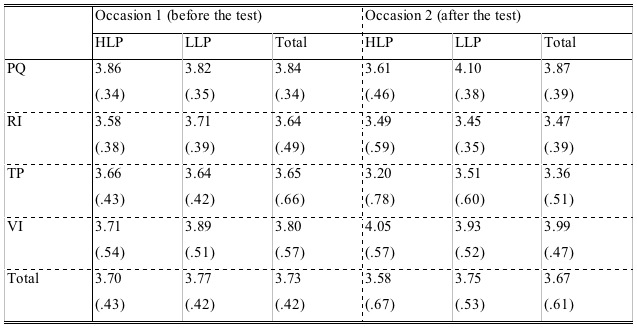
The results of the overall analysis of the means for specific anxiety are shown in Table 6. With respect to the between-subject factors, a significant main effect was found for type of listening support (LS) (p = .000), but its effect size (as measured by partial eta squared) accounts for only 15% of the total variance in task anxiety. The main effect for level of listening proficiency (LP) was not significant. Similarly, in the within-subject factors, no main effect was found for occasion (O), indicating that the students' anxiety level did not change significantly before and after taking the test. Although the interaction effect for O × LS was significant, the effect size was only .13. No significant interaction effect was found for O × LP, which meant LP did not have any real influence on the test-takers' task anxiety.
Table 6. Summary of ANOVAR of task anxiety for variables of LS, LP and occasion
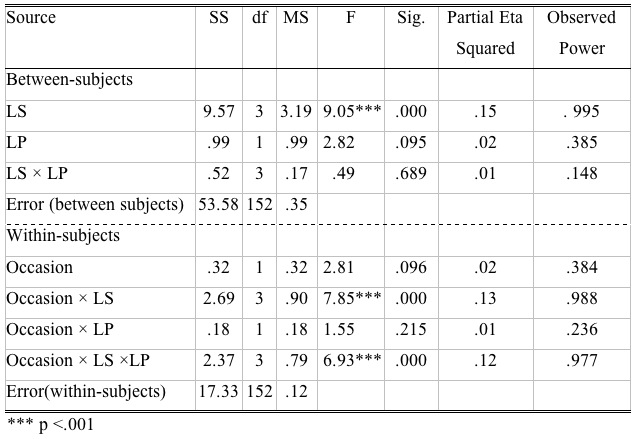
The most interesting result was the significant three-way interaction effect (LS × LP × O) (p =.000), which meant that we needed to test the significance of two-way interactions, given all levels of the third variable separately (see Table 7). Here again, though, it should be noted that the effect size for LS × LP × O was .12, meaning that the interaction accounted for only a small proportion of the total variance in task anxiety. The two-way interactions were significant only in the following four cases: LS × LP in Occasion 2, LS × Occasion in HLP, LS × Occasion in the LLP, and LP × Occasion in PQ.
Table 7. The two-way interactions for (LS, LP), (LS, Occasion), and (LP, Occasion) given the third variable
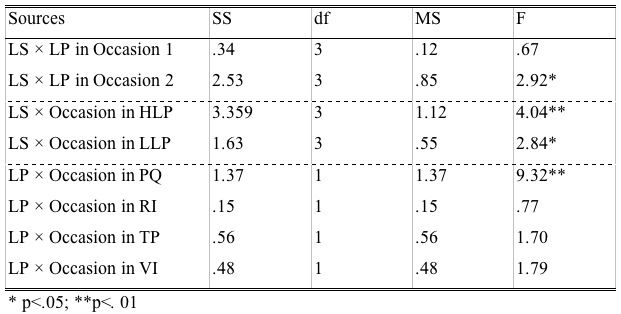
In addition, the main effect of each variable given the others was tested (see Table 8). The main effect of LS in HLP and Occasion 2 showed that, after the test, higher proficiency students in the VI group were more anxious than those in the RI and TP groups. On the other hand, the main effect of LS in LLP and Occasion 2 indicated that lower proficiency students in both the PQ and VI groups were more anxious than those in the RI and TP groups.
Table 8. The test of significance for the main effect of each variable given the others on listening task anxiety
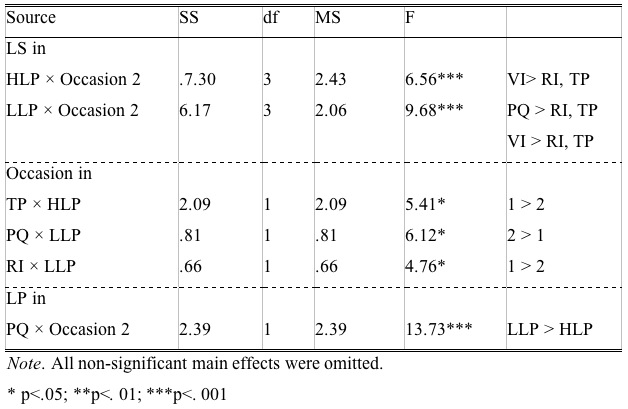
Given LP at the higher level, the main effect of Occasion revealed that only students in the TP group felt less anxious after the task (p <.05). There was no significant difference in anxiety before and after the task for the rest of the groups. When looking at the case of the LLP level, we found the students in the PQ group felt much more anxious after the task (p <.05), whereas the students in the RI group were significantly less so (p <.05).
Finally, the effect of LP given LS and Occasion was less salient. It showed only that after the task lower proficiency students were more anxious than higher proficiency ones in the PQ group (p <. 001).
These results showed that the participants' task anxiety differed from one group to another more substantially after the test, whereas they felt equally anxious beforehand, regardless of their listening support group or their level of listening proficiency (see Figures 1 and 2). For the different levels of proficiency in each group, there was no consistent pattern as to whether one group was more or less anxious after the test. Finally, before the test the participants' proficiency had minimal effect on the task anxiety in each individual LS group; after the test, it was only in the PQ group that the lower proficiency students were more anxious than the higher ones.
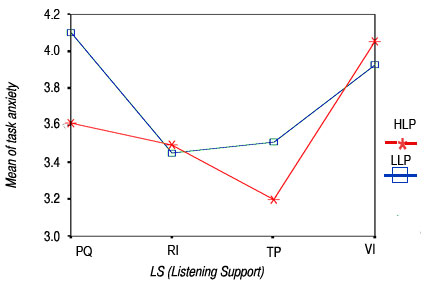
Figure 1. The interaction between listening support (LS) and listening proficiency (LP) before the test
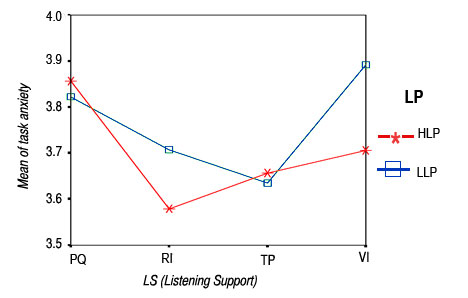
Figure 2. The interaction between listening support (LS) and listening proficiency (LP) after the test
The ANOVAR results showed a significant three-way interaction effect for the types of LS, the participants' LP, and Occasions, indicating that one single factor was not sufficient to explain how the participants' anxiety changed; their task anxiety was affected differently by the three factors. Therefore, with regard to the first research question, whether various types of listening support would affect learners' task anxiety differently, the results showed that there was no significant difference in the students' pre-test anxiety across the four groups. All of them, regardless of the form of LS and their LP, reported relatively high anxiety, with a combined mean rating of 3.73. However, a significant difference between LS groups was found after the test. At the higher proficiency level, the VI group was noticeably more anxious than the RI and TP groups, whereas at the lower level, the PQ and VI groups had significantly higher anxiety than the RI and TP subgroups.
In the interviews after the test, the participants gave four main reasons for their anxiety before they took the test. The first reason, being allowed to listen only once, was reported by the students who were not in the RI group. They stated that they were nervous about a single hearing because they had to process the linguistic elements as well as remembering what the speaker said at the same time, which was a demanding task. The second reason for anxiety, reported by more than half of the interviewees, was their concern about the mark they would obtain. The lower proficiency students were worried about failing the course, since the test counted as 60% of the final grade, whereas those with higher proficiency were more concerned about the way that the score would reflect on their competence: they would not be satisfied if the score was just high enough to pass the course.
The third cause of anxiety was that some students worried that the test would be very difficult for them as compared to other students in the class. They were conscious of being in competition with others, not just in their current course but also--because of the importance of English for employment in the corporate sector in Taiwan--as future competitors in the job market. Lack of confidence was the fourth factor affecting their anxiety before the test. One of the students expressed the view that she had no confidence in doing well in this course, and she would feel very bad if the input meant nothing to her but a string of unrecognizable sounds. These four reasons, then, appear to have been the main sources of the high anxiety before the test.
Although no significant difference in pre-test anxiety was found among any of the subgroups, it was worth finding out whether giving the test-takers some sort of listening support reduced their level of anxiety before the test (ABT), as compared with the general listening test anxiety (GLTA), which they had reported three weeks earlier. The mean ratings for GLTA and ABT in each group are reported separately by proficiency level (HLP and LLP) in Table 9. Seven of the eight subgroups had a lower mean for their ABT as compared to their GLTA, although in most cases the difference was slight. On the other hand, the higher proficiency students in the TP group had pre-test anxiety that was a little higher than their GLTA. This evidence suggests that any effect of listening support on test anxiety was rather small. The most likely reason was that this was a high-stakes test, and at the time they filled out the questionnaire, they did not know what score they had achieved.
Table 9. Comparison of the means for ABT and GLTA in each group
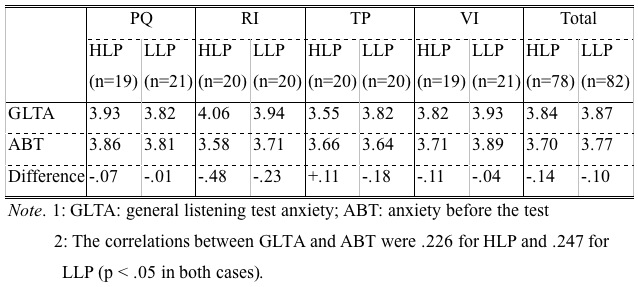
The one exception was in the Repeated Input group, particularly the higher proficiency students, who had a more substantial difference between their GLTA and ABT ratings. These students had had the highest mean GLTA score of any subgroup, but their mean ABT was comparable to those of the other subgroups. This indicates that knowing that they would be able to listen to the test input three times may have reduced their level of test anxiety a little. The finding supports Teng's (1998) and Chang et al.'s (1993) results, and also reflects the fact that repeated input not only enhanced the learners' comprehension but also reduced their anxiety.
Although the interaction of LS and LP at Occasion 1 (before the test) showed no significant effect, a significant interaction was found at Occasion 2, indicating the participants' perceptions varied to a significant degree after the test. As shown in Table 10, mean AAT decreased for higher proficiency students in the PQ, RI and TP groups and also for the lower proficiency students in the RI and TP groups, but increased for the lower students in the PQ group as well as both higher and lower proficiency students in the VI group. A significant negative correlation was found between AAT and the listening comprehension scores for the participants overall, showing that the higher the level of anxiety the students reported, the lower their listening performance was.
Table 10. Comparison of the means for AAT and listening comprehension
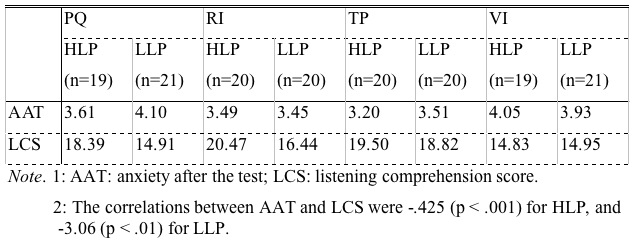
The second research question asked whether or not students' task anxiety would change significantly after the test according to different types of listening support (LS). Because the three-way interaction was significant, the answer to this question involves three factors: LS, LP, and Occasion. The higher-proficiency students in the TP group and lower-proficiency students in the RI group felt less anxious after the task; however, the lower students in the PQ group were the only subgroup that felt more anxious after the task. There was no significant difference between pre-task and post-task anxiety in the rest of the groups.
First, we examine the subgroup whose level of anxiety changed. That the less proficient students in the PQ group felt more anxious after the test was understandable. In the interview, more than any other group, they reported having difficulties since question preview was the only form of listening support they received. In addition, question preview might not have substantially helped them achieve higher scores because some unfamiliar vocabulary prevented them from fully understanding the questions. The higher proficiency students in the TP group and the lower students in the RI group felt less anxious after the task because of how they perceived the effectiveness of the LS, as reported in the interviews. In the case of the less proficient students in the RI group, they were less anxious even though--as their scores revealed--they did not perform very well on the test. Despite not scoring very high, their task anxiety was significantly reduced after the test. The most likely reason, according to their interview responses, was their belief in the effectiveness of repeated input.
As for the five subgroups with no significant change in their anxiety after the test, it should be pointed out that at the time the students completed the post-test questionnaire and participated in the interviews, the test had not been scored. Therefore, concern about how well they had performed in this relatively high-stakes test might have offset any positive feeling they had about the effect of the listening support they received.
The two-way interaction effect between LP and Occasion on LS was significant only for the PQ group. The most likely reason for this was that the more proficient students in the PQ group could rely on their language competence to compensate for the lack of any other form of listening support. Therefore, they performed comparably to the RI and TP groups. The less proficient students would have needed more support to perform well.
No significant difference was found between higher and lower proficiency students in the other groups after the task. In the RI and TP groups, the anxiety after the test of both proficiency subgroups was lower than their ABT because (as reported in the interviews) they perceived that they had performed better on the test as a result of their listening support. However, for the VI group it was the opposite. The AAT for both more and less proficient students in this group increased. Although the students in the VI group had expressed very positive attitudes about the opportunity to study the vocabulary before the test, this kind of support did not in fact help them to understand the test input better. Thus, they all felt equally anxious.
The three-way interaction indicated that the single factor of listening support was not sufficient to account for changes in the test-takers' task anxiety. Their anxiety levels were affected by three variables: the types of listening support, their level of listening proficiency, and occasion. The overall results can be summarized as follows:
The study used four types of listening support to investigate the effects of support on comprehension and anxiety. At the pre-test stage, although most of the LP subgroups had somewhat lower anxiety about this test than their general level of anxiety about listening tests (GLTA), there were no significant differences among the four treatment groups. Thus, their levels of pre-test anxiety were similar, regardless of whether they had experienced some pre-teaching (as in the VI and TP groups) or they were anticipating support during the test itself (PQ and RI groups). All four groups reported high levels of anxiety, which reflected the fact that the test would have a significant impact on their final course grades. It was natural for them to be anxious about a high-stakes test, particularly those whose listening proficiency was low. As Horwitz et al. (1986) point out, "as long as foreign language learning takes place in a formal classroom setting where evaluation is inextricably tied to performance, anxiety is likely to continue to flourish" (p.131). Obviously, language test anxiety is not easily reduced.
After the test, there were differences among the four groups, revealed by both the objective evidence of the listening test scores and the more subjective reports of anxiety levels from the questionnaires and the interviews. Generally speaking, the test scores showed that providing topical knowledge and repeated input were more effective than giving vocabulary instruction or just allowing preview of the questions. The effectiveness of the first two forms of support was confirmed by the significantly lower levels of post-test anxiety among those two groups, as compared to the VI and PQ groups. The findings confirm what previous studies have shown to be the facilitating effect on listening comprehension of giving test-takers more than one opportunity to listen to the input, and they provide new evidence of the value of pre-teaching the content of the input material.
The other two forms of listening support were not as effective, and this was reflected in higher levels of anxiety after the test among the students who experienced them, except for the HLP students in the PQ group. There appear to have been a couple of somewhat interrelated factors which came into play. The first was the students' level of listening proficiency. In the PQ group, the higher LP students performed significantly better and reported in the interview that they had no difficulty understanding the test items, so that they could more confidently predict the content of the input material. On the other hand, the lower LP students struggled to comprehend the test items. In the case of the VI treatment, both subgroups performed poorly and were highly anxious after the test. This kind of listening support encouraged a bottom-up approach to the processing of the input, even among the more proficient students in the group, and resulted in fairly poor performance on the test.
The second factor that influenced the anxiety level of the VI and PQ groups was the role of listening strategies in test performance. It is worth noting that the PQ group had the most limited form of support, which was the opportunity to preview the questions. In fact, all four groups had this opportunity, but the other three had a further enhancement. The question then was how effectively the students in the various groups made use of whatever form of support was available to them. The more proficient students in the PQ group were able to take advantage of the limited support that they had, more so than the VI students, who were narrowly focused on memorizing the items on their vocabulary list. It was possible that the VI students wrongly believed, as did Boyle's (1984) learners, that "If you know the words, you know what it's all about" (p. 37); however, they became very anxious as a result of their inability to commit all the words to memory. Thus, the VI students did not take the opportunity to prepare more strategically for the test by using the list as the basis for predicting the topics and preparing for the test in a more general way.
Although the students' post-task anxiety was not greatly reduced on the whole, this does not necessarily mean that the inclusion of listening support in listening tests is ineffective. As Graham (2006) notes, learners may have certain beliefs about listening, which may influence the way they approach a listening task, especially when the stakes are high. To help learners make good use of the information provided and thus to enhance the effectiveness of listening support, this study suggests that there is a need for strategy instruction in conjunction with the provision of listening support in a test, or test-takers may not know how to make use of the information to increase their understanding of oral input. The interviews revealed that the students concentrated too much on language decoding rather than planning how to listen and what to focus on. Vandergrift's (1997) research shows that the higher the learners' proficiency level, the greater their metacognitive strategy use is. A lower level of listening proficiency means that a student depends more on language cues and thus lacks overall comprehension. According to Vandergrift (1999), a teacher should teach students to plan for listening, to monitor their comprehension and to evaluate the effectiveness of their strategy use after listening. Therefore, the various forms of listening support implemented in this study should probably be complemented by appropriate strategy instruction if learners are to experience a reduction in anxiety through having suitable strategies for coping with the listening test task.
[1] There were actually more than 40 students in each class. However, exactly 40 participants were selected from each one by excluding students with poor attendance records or a low level of commitment to the course, such as athletes on scholarship.
[2] Statistical Package for the Social Sciences.
John Read is an associate professor in the department of Applied Language Studies and Linguistics at the University of Auckland, New Zealand. His research interests include language testing and assessment, with a particular focus on vocabulary assessment and the testing of English for academic purposes. He has been extensively involved with the International English Language Testing System as a researcher consultant and test administrator. He was until recently co-editor of Language Testing.
Aneiro, S. (1989). The influence of receiver apprehension in foreign language learners on listening comprehension among Puerto Rican college students. Unpublished doctoral dissertation, New York University.
Arnold, J. (2000). Seeing through listening comprehension exam anxiety. TESOL Quarterly, 34, 777-786.
Bachman L. F., & Palmer A. S. (1996). Language testing in practice. Oxford: Oxford University Press.
Berne, J. E. (1995). How does varying pre-listening activities affect second language listening comprehension? Hispania,78, 316-19.
Blau, E. K. (1990). The effect of syntax, speed, and pauses on listening comprehension. TESOL Quarterly, 24, 746-53.
Boyle, J. P. (1984). Factors affecting listening comprehension. English Language Teaching Journal, 38, 34-38.
Brown, G. (1990). Listening to spoken English. London: Longman.
Buck, G. (1991). The test of listening comprehension: An introspective study Language Testing, 8, 67-91.
Buck, G. (2001). Assessing listening. Cambridge, UK: Cambridge University Press.
Cervantes, R. & Gainer, G. (1992). The effects of syntactic simplification and repetition on listening comprehension. TESOL Quarterly,24, 767-70.
Chang, A. C-S. (2005a). Question preview in EFL listening comprehension tests. New Zealand Studies in Applied Linguistics, 11, 75-95.
Chang, A. C-S. (2005b). How does listening anxiety affect the strategy use of Chinese students studying overseas? In Proceedings of 2005 International Conference and Workshop on TEFL & Applied Linguistics (pp. 1-11). Taipei: Crane Publishing.
Chang, A. C-S. & Read, J. (2006). The effects of listening support on the listening performance of EFL learners. TESOL Quarterly, 40, 375-397.
Chang, Y. L., Chang, T. S., & Kou, C. H. (1993). Listening difficulties and learner strategies of non-native speakers. In Proceedings of the Tenth Conference on English Teaching and Learning in the Republic of China (pp. 145-172). Taipei: Crane Publishing.
Chaudron, C. (1983). Simplification of input: Topic and reinstatement and their effects on l2 learner's recognition and recall. TESOL Quarterly 17, 437-58.
Chen, T-Y. & Chang, B. Y. (2004). The relationship between foreign language anxiety and learning difficulty. Foreign Language Annals, 37, 279-289.
Cheng, H. (2004). A comparison of multiple-choice and open-ended response formats for the assessment of listening proficiency in English. Foreign Language Annals, 37, 544-555.
Chiang, C. C. & Dunkel, P. (1992). The effect of speech modification, prior knowledge and listening proficiency on EFL lecture learning. TESOL Quarterly, 26, 345-374.
Cohen, A. D. (1984). On taking language tests: What the students report. Language Testing, 1, 70-81.
Derwing, T. & Munro, M. 2001. What speaking rates do non-native listeners prefer? Applied Linguistics, 22, 324-337.
Dunkel, P. (1991). Listening in the native and the second/foreign language: Toward an integration of research and practice. TESOL Quarterly, 25, 431-457.
Elkhafaifi, H. (2005). Listening comprehension and anxiety in the Arabic language classroom. Modern Language Journal, 89, 206-220.
Foley, B. H. (1994). Listen to me. Boston: Heinle & Heinle.
Gardner, R. C. & MacIntyre, P. D. (1993). On the measurement of affective variables in second language learning. Language Learning, 43, 157-194.
Graham, S. (2006). Listening comprehension: The learners' perspective. System, 34, 165-182.
Graves, M.F. (1986). Vocabulary learning and instruction. Review of Research in Education, 13, 49-89.
Griffiths, R. (1990). Speech rate and NNS comprehension: A preliminary study in time-benefit analysis. Language Learning, 40, 311-336.
Griffiths, R. (1991). Pausological research in an L2 context: A rationale and review of selected studies. Applied Linguistics, 12, 345-364.
Groot, P.J.M. (1975). Testing communicative competence in listening comprehension. In R.L. Jones & B. Spolsky (Eds.), Testing language proficiency. Arlington, VA: Center for Applied Linguistics.
Hsieh, L.T. (1999). The effects of pre-reading vocabulary instruction and cultural background knowledge activation on Chinese junior college fourth-year students' EFL reading. In Proceedings of the Sixteenth Conference on English Teaching and learning in the Republic of China (pp. 227-240). Taipei: Crane Publishing.
Horwitz, E. K., Horwitz, M. B., & Cope J. A. (1986). Foreign language classroom anxiety. Modern Language Journal, 70, 125-132.
In'nami, Y. (2006). The effects of test anxiety on listening performance. System, 34, 317-340.
Jensen, E.D. & Vinther, T. (2003). Exact repetition as input enhancement in second language acquisition. Language Learning 53, 373-428.
Liu, M. (2006). Anxiety in Chinese EFL students at different proficiency levels. System, 34, 301-316.
Long, D. R. (1990). What you don't know can't help you: An exploratory study of background knowledge and second language listening comprehension. Studies in Second Language Acquisition, 12, 65-80.
MacIntyre, P. D. & Gardner, R.C. (1989). Anxiety and second language learning: Toward a theoretical clarification. Language Learning, 39, 251-275.
Major, R., Fitzmaurice, S.M., Bunta, F., & Balasubramanian, C. (2005). Testing the effects of regional, ethnic, and international dialects of English on listening comprehension. Language Learning 55, 37-69.
Markham, P. & Latham, M.L. (1987). The influence of religion-specific background knowledge on the listening comprehension of adult second-language students. Language Learning 37, 157-170.
Masny, D. & Foxall, J. (1992). Writing apprehension in L2. ERIC Document Reproduction Service, No. ED352844, Washington, DC: ERIC Clearinghouse on Language and Linguistics.
Mills, N., Pajares, F., & Herron, C. (2006). A reevaluation of the role of anxiety: Self-efficacy, anxiety, and their relation to reading and listening proficiency. Foreign Language Annals, 39, 276-295.
Read, J. (2002). The use of interactive input in EAP listening assessment. Journal of English for Academic Purposes, 1, 105-119.
Rost, M. (1990). Listening in language learning. London: Longman.
Rost, M. (2001). Teaching and researching listening. Harlow, UK: Longman.
Rost, M. (2006). Areas of research that influence L2 instruction. In Usó-Juan, E. & A. Martínez-Flor (Eds.), Current trends in the development and teaching of the four language skills (pp. 47-74). Berlin: Mouton de Gruyter.
Saito Y., Garza, Y. J., & Horwitz, E. K. (1999). Foreign language reading anxiety. Modern Language Journal, 83, 202-218.
Schmidt-Rinehart, B.C. (1994). The effects of topic familiarity on second language listening comprehension. Modern Language Journal, 78, 179-189.
Sherman, J. (1997). The effect of question preview in listening comprehension tests. Language Testing, 14, 185-213.
Shohamy, E. & Inbar, O. (1991). Validation of listening comprehension tests: The effect of text and question type. Language Testing,8, 23-40.
Stahl, S.A., Jacobson, M.G., Davis, C.E., & Davis, R.L. (1989). Prior knowledge and difficult vocabulary in the comprehension of unfamiliar text. Reading Research Quarterly, 24, 27-43.
Steinberg, F.S. & Horwitz, E.K. (1986). The effect of induced anxiety on the denotative and interpretive content of second language speech. TESOL Quarterly, 20, 131-136.
Tauroza, S. & Allison, D. (1990). Speech rates in British English. Applied Linguistics, 11, 90-105.
Teng, H. C. (1996). Effects of cultural schemata and visual cues on Chinese students' EFL listening comprehension. In Papers from the Eleventh Conference on English Teaching and Learning in the Republic of China (pp. 533-550). Taipei: Crane Publishing.
Teng, H. C. (1998). The effects of text types and task types on English listening comprehension. English Teaching Journal, 23, 5-18.
Underwood, M. (1989). Teaching listening. London: Longman.
Ur, P. (1984). Teaching listening comprehension. London: Longman.
Vandergrift, L. (1997). The Cinderella of communication strategies: Reception strategies in interactive listening. Modern Language Journal, 81, 494-505.
Vandergrift, L. (1999). Facilitating second language listening comprehension: Acquiring successful strategies. ELT Journal, 53, 168-176.
Vogely A. J. (1998). Listening comprehension anxiety: Students' reported sources and solutions. Foreign Language Annals, 31, 67-80.
Weir, C. (1993). Understanding and developing language tests. Hemel Hempstead, UK: Prentice-Hall.
Young, D. J. (1986). The relationship between anxiety and foreign language oral proficiency ratings. Foreign Language Annals, 19, 439-445.
Young, D. J. (1990). An investigation of students' perspectives on anxiety and speaking. Foreign Language Annals, 23, 53.
|
© Copyright rests with authors. Please cite TESL-EJ appropriately.
Editor's Note: The HTML version contains no page numbers. Please use the PDF version of this article for citations. |
